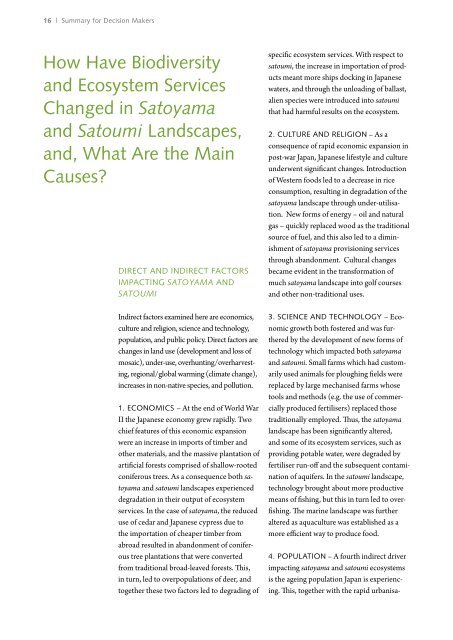Satoyama-Satoumi Ecosystems and Human Well-Being - UNU-IAS ...
Satoyama-Satoumi Ecosystems and Human Well-Being - UNU-IAS ...
Satoyama-Satoumi Ecosystems and Human Well-Being - UNU-IAS ...
You also want an ePaper? Increase the reach of your titles
YUMPU automatically turns print PDFs into web optimized ePapers that Google loves.
16 | Summary for Decision Makers<br />
How Have Biodiversity<br />
<strong>and</strong> Ecosystem Services<br />
Changed in <strong>Satoyama</strong><br />
<strong>and</strong> <strong>Satoumi</strong> L<strong>and</strong>scapes,<br />
<strong>and</strong>, What Are the Main<br />
Causes?<br />
Direct <strong>and</strong> indirect factors<br />
impacting satoyama <strong>and</strong><br />
satoumi<br />
Indirect factors examined here are economics,<br />
culture <strong>and</strong> religion, science <strong>and</strong> technology,<br />
population, <strong>and</strong> public policy. Direct factors are<br />
changes in l<strong>and</strong> use (development <strong>and</strong> loss of<br />
mosaic), under-use, overhunting/overharvesting,<br />
regional/global warming (climate change),<br />
increases in non-native species, <strong>and</strong> pollution.<br />
1. Economics – At the end of World War<br />
II the Japanese economy grew rapidly. Two<br />
chief features of this economic expansion<br />
were an increase in imports of timber <strong>and</strong><br />
other materials, <strong>and</strong> the massive plantation of<br />
artificial forests comprised of shallow-rooted<br />
coniferous trees. As a consequence both satoyama<br />
<strong>and</strong> satoumi l<strong>and</strong>scapes experienced<br />
degradation in their output of ecosystem<br />
services. In the case of satoyama, the reduced<br />
use of cedar <strong>and</strong> Japanese cypress due to<br />
the importation of cheaper timber from<br />
abroad resulted in ab<strong>and</strong>onment of coniferous<br />
tree plantations that were converted<br />
from traditional broad-leaved forests. This,<br />
in turn, led to overpopulations of deer, <strong>and</strong><br />
together these two factors led to degrading of<br />
specific ecosystem services. With respect to<br />
satoumi, the increase in importation of products<br />
meant more ships docking in Japanese<br />
waters, <strong>and</strong> through the unloading of ballast,<br />
alien species were introduced into satoumi<br />
that had harmful results on the ecosystem.<br />
2. Culture <strong>and</strong> Religion – As a<br />
consequence of rapid economic expansion in<br />
post-war Japan, Japanese lifestyle <strong>and</strong> culture<br />
underwent significant changes. Introduction<br />
of Western foods led to a decrease in rice<br />
consumption, resulting in degradation of the<br />
satoyama l<strong>and</strong>scape through under-utilisation.<br />
New forms of energy – oil <strong>and</strong> natural<br />
gas – quickly replaced wood as the traditional<br />
source of fuel, <strong>and</strong> this also led to a diminishment<br />
of satoyama provisioning services<br />
through ab<strong>and</strong>onment. Cultural changes<br />
became evident in the transformation of<br />
much satoyama l<strong>and</strong>scape into golf courses<br />
<strong>and</strong> other non-traditional uses.<br />
3. Science <strong>and</strong> Technology – Economic<br />
growth both fostered <strong>and</strong> was furthered<br />
by the development of new forms of<br />
technology which impacted both satoyama<br />
<strong>and</strong> satoumi. Small farms which had customarily<br />
used animals for ploughing fields were<br />
replaced by large mechanised farms whose<br />
tools <strong>and</strong> methods (e.g. the use of commercially<br />
produced fertilisers) replaced those<br />
traditionally employed. Thus, the satoyama<br />
l<strong>and</strong>scape has been significantly altered,<br />
<strong>and</strong> some of its ecosystem services, such as<br />
providing potable water, were degraded by<br />
fertiliser run-off <strong>and</strong> the subsequent contamination<br />
of aquifers. In the satoumi l<strong>and</strong>scape,<br />
technology brought about more productive<br />
means of fishing, but this in turn led to overfishing.<br />
The marine l<strong>and</strong>scape was further<br />
altered as aquaculture was established as a<br />
more efficient way to produce food.<br />
4. Population – A fourth indirect driver<br />
impacting satoyama <strong>and</strong> satoumi ecosystems<br />
is the ageing population Japan is experiencing.<br />
This, together with the rapid urbanisa-
















